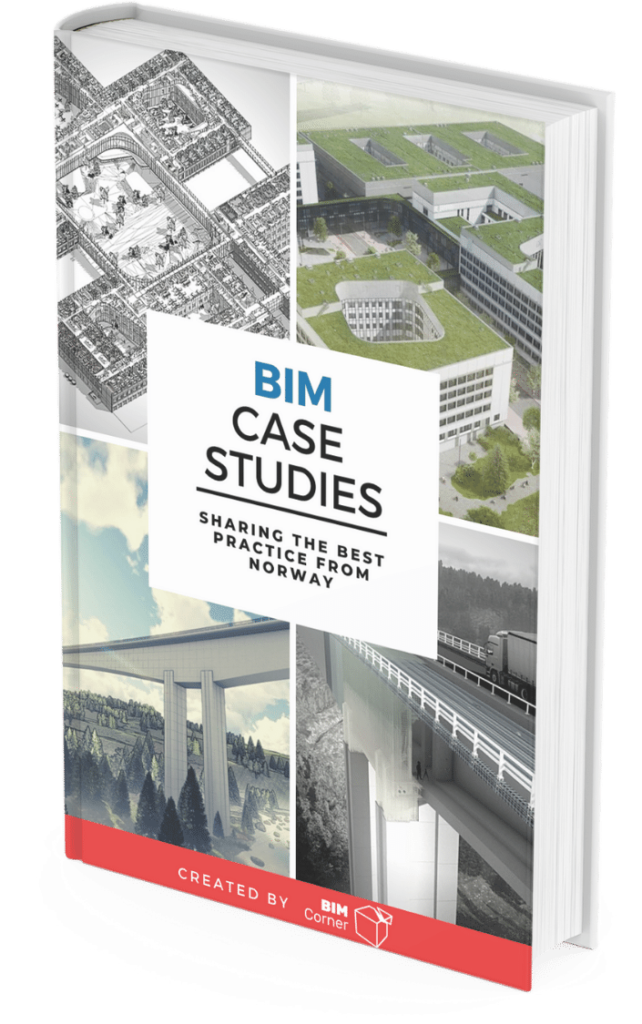What do you actually do?
When Women in BIM asked 461 professionals across 47 countries this simple question, the answers revealed something urgent.
There is a quiet identity crisis happening across BIM departments worldwide, and it started long before AI entered the conversation. AI doesn’t create this weakness; it exposes it. It will automate work that is rule-based, not judgment-based. To survive and thrive, you must focus on your information foundations, develop critical thinking, and secure your value.
Through Women in BIM’s 2024 Global Work Survey, we asked 461 professionals across 47 countries in the AEC industry a simple question: what do you actually do?
The answers revealed something we needed to address:
- 87 different job titles appeared: BIM Manager. BIM Coordinator. Digital Construction
Lead. Information Manager. Virtual Design Coordinator. The list goes on.
- Many dramatically different titles described nearly identical day-to-day work.
- Many identical titles described completely different jobs, often with pay bands that varied by tens of thousands of pounds.
In short: there is a fundamental lack of clarity, consistency, and fair valuation of expertise within digital construction roles.
With AI entering the conversation, this problem is becoming urgent.
The big question is: what can we do about that? And why are data quality and EIR so important?
This post was written by BIM Corner’s Guest Author, Willow Williams.
Table of contents
Survey Results That Made Us Pause
Let’s start with the data.
When we analysed the responses, three things stood out:
- The “Manager” title is inconsistent. “BIM Manager” was one of the most common titles, but responsibilities varied widely, from leading digital transformation to producing clash detection reports. Some managed teams of 20. Others worked entirely alone. The only constant was the word itself.
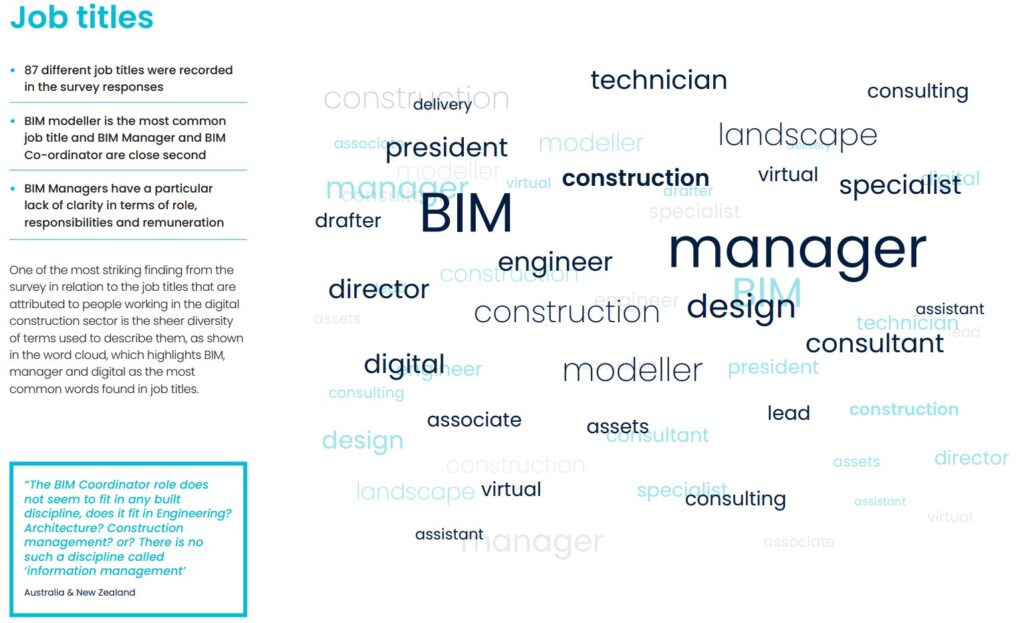
- Experience doesn’t equal progression. Even those with postgraduate or doctoral qualifications often remain in technical roles, while others with fewer years of experience move quickly into senior positions. Something other than expertise is being valued, but what?
- Training is informal.
37% received no formal training for their current role. Of those who did, over half said it focused mainly on software use, not methodology, problem-solving, or leadership. YouTube, LinkedIn Learning, and colleagues filled the gaps.
These patterns existed long before AI. But AI makes them more visible, and more consequential.
These inconsistencies might seem like an HR issue. But they become a technical liability when AI enters the picture. Here’s why.
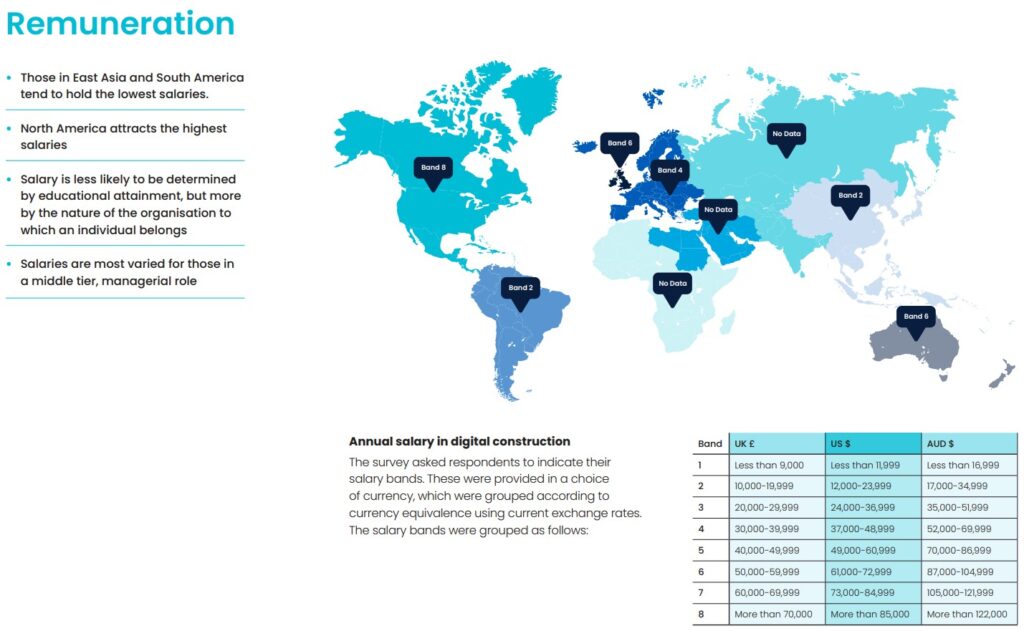
Why AI Makes This Problem Urgent
Software vendors frame AI as a productivity tool: automating repetitive tasks so humans can focus on “higher-value work.”
That’s true, but incomplete.
New AI tools aren’t just producing drawings. They’re recognising patterns, summarising meetings, and even suggesting decisions.
So the question isn’t can AI automate technical tasks?
It can.
The real question is: how much of our daily BIM work is rule-based and therefore automatable, versus requiring human judgment?
The uncomfortable answer: more than most job descriptions acknowledge.
And the line between rule-based and judgment-based work?
It all comes down to information quality.
The Skills Gap That Preceded AI (And Will Outlast It)
Over half of survey respondents said they train others as part of their role. Often, it’s the technical specialists, the ones with the least influence, who carry the most current knowledge.
They’re training managers, leading adoption, and yet sitting at the bottom of pay bands.
This mismatch already created inefficiency. With AI, it becomes a liability.
What will protect your role now:
- Critical thinking. The ability to ask the right questions, spot risks, and make judgment calls rooted in project realities.
- AI literacy. Not just using AI, but knowing its limits, validating outputs, and spotting errors others miss.
Right now, many professionals struggle to evaluate human work, let alone algorithmic output. AI doesn’t create that weakness. It exposes it.
But another, often ignored, factor matters just as much: data quality.
The Part We Should Talk More About: Data Quality
AI is only as good as the data it works with. Poor data isn’t just an inconvenience, it’s a risk.
When humans encounter unstructured data, they improvise.
When AI encounters unstructured data, it confidently returns wrong answers.
That gap between “looks right” and “is right” is where project risk lives.
Where data quality usually breaks down:
Inconsistent naming conventions
Metadata too incomplete for AI search
EIRs and BEPs that sit in PDFs no one reads
Classification applied differently across teams
These aren’t new issues. But they’re about to become expensive ones.
When job roles are unclear, no one takes ownership. BIM Managers assume Coordinators are enforcing the rules. Coordinators assume it’s the Information Manager. And so on.
AI doesn’t care about your job title. It cares whether your information foundation is solid.
This is where your EIR matters.
Start Here: Making Your EIR Work
Exchange Information Requirements should shape how project data gets structured, validated, and delivered.
Here’s how to start:
- Build it modular
Break EIR into standalone sections: naming, LOIN by stage, software, coordination, delivery milestones.
- Make it searchable with AI tools
Upload the EIR into your enterprise knowledge base. Tools like Microsoft Copilot let users ask questions in plain language.
Check IT compliance
Ensure tools used for storing or querying EIRs are approved and secure.Embed validation checkpoints
State not just the rule, but how and when compliance is verified.Tie requirements to roles
Spell out who does what, when, and with what tool, removing ambiguity.Version control with change logs
Record why requirements change and track cascading impacts.
It can feel overwhelming, but you can start small.
Five Actions You Can Take This Week
No new tools needed. Just insight and initiative.
1. Audit Your Reality
Where does your EIR align (or clash) with real delivery?
• Check one recent deliverable against your EIR
• Note where it diverges
This highlights the gap between theory and practice.
2. Find the Human Layer
What can’t be automated?
Interview three colleagues:
• What slows you down?
• What’s unclear in the EIR?
• What do you wish it told you?
• Track your own work for a week:
• Note three moments per day when judgment was required
• Ask: What context did I apply that software wouldn’t have?
3. Test AI Boundaries
What does AI understand, and what doesn’t it?
• Upload EIR/BEP to an approved AI tool
• Ask common project questions
• Note which answers are correct vs. incomplete or wrong
4. Document What Matters
Update your EIR based on what you’ve learned
• Add missing context
• Clarify where human input is essential
• Remove legacy requirements nobody follows
5. Make It Accessible
A document nobody reads is a document nobody uses
• Extract five core requirements (naming, LOD, formats, etc.)
• Create a one-page visual
• Place it in your team’s workspace (SharePoint, Miro, etc.)
The Loop
Each of these steps feeds your next audit. Repeat quarterly.
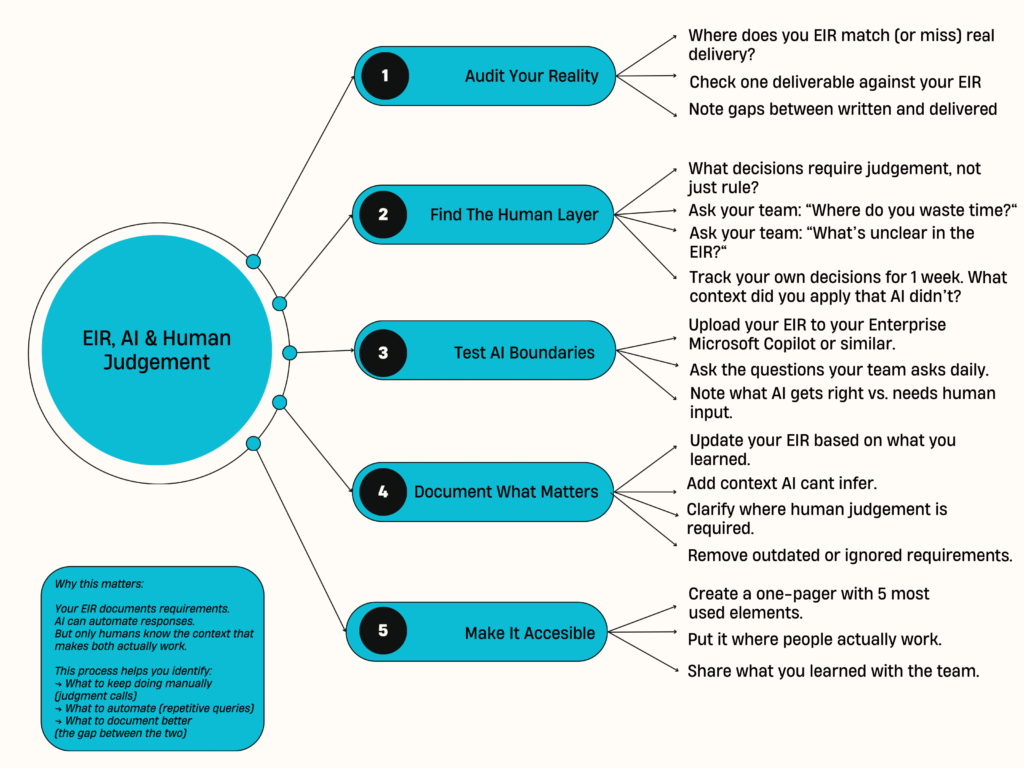
What This Means for Careers
These five actions aren’t just good practice.
They help you prove your value.
• Audit = Quality control
• Track judgment = Document irreplaceable skills
• Test AI = Show AI literacy
• Clarify documents = Demonstrate leadership
In other words: you transform vague BIM tasks into strategic assets.
Forget job titles. Focus on what you do that matters.
Ask yourself:
• Is most of my work rules-based or judgment-based?
• Am I being valued for tools, or thinking?
• Do I train others while lacking authority myself?
• Am I the quiet enforcer of data quality?
If the answer is yes, you may be under-recognised, but your role is critical.
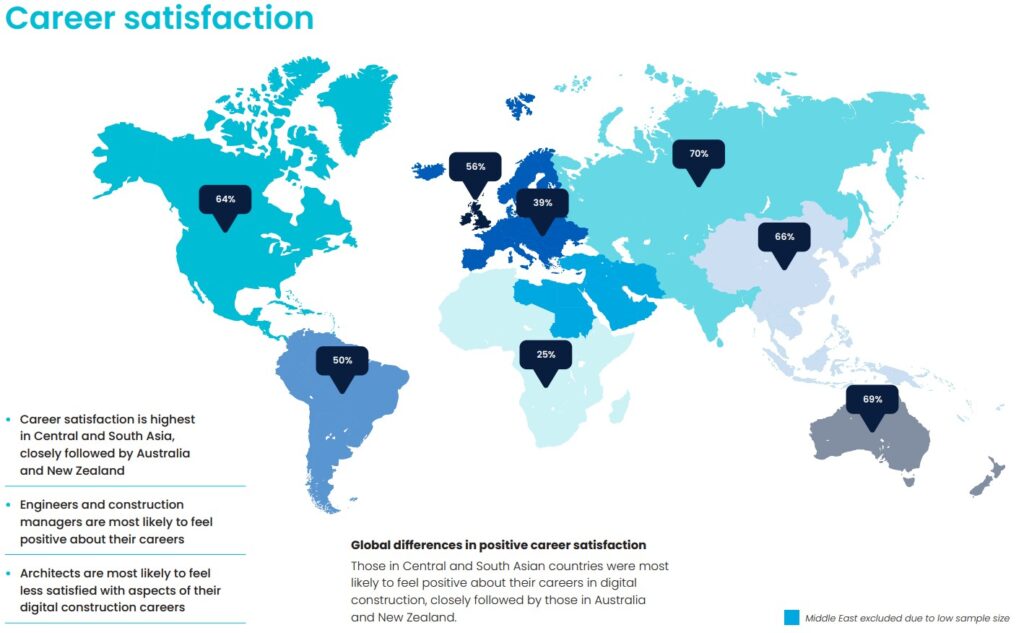
Conclusion: Clarity Through Action
The ambiguity around BIM roles is not a side issue. It’s central to whether AI strengthens or destabilises your career.
We can confront this now, or wait until AI redraws the map without us.
Clarity is coming. It won’t arrive through job titles. It will arrive through action.
And when asked “What do you actually do?”
You’ll have a clear, strategic answer grounded in information quality, critical thinking, and human judgment.
The Loop
Unclear roles → Poor EIR → Data quality suffers → AI scales the issue →
Work value unclear → Job security at risk
Reversed:
Audit → Find judgment-based work → Test AI → Improve docs →
Tie to roles → Clarify value → Update EIR → Repeat
This is more than EIR reform. It’s how you future-proof your role.
⸻
Ready to start?
Download the 5-step action plan here.
Or share this article with someone navigating the BIM role shuffle.
Clarity isn’t just strategy.
It’s how you prove your value when everything else can be automated.
This post was written by BIM Corner’s Guest Author, Willow Williams.
References



